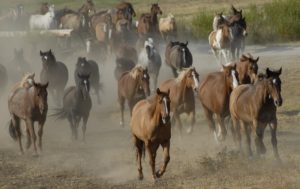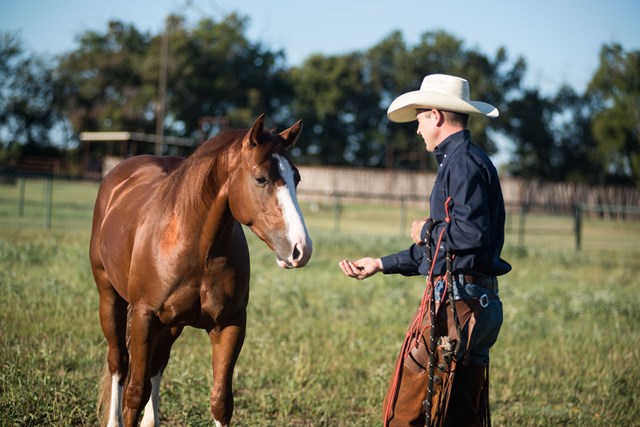By Chris Morrow, DVM and Matt McMillan, PhD
Tying-up in horses is a ‘catch-all’ term used by many horse men and women who are referring to a muscle cramping, soreness, or unwillingness to move in horses that is generally brought on by exercise and/or excitement. It usually comes about at the beginning of exercise as the muscles warm up, or at the end of exhaustive exercise. Causes of tying-up in horses may be environmental (diet and exercise regime) and/or genetic predisposal to a particular disease. If chronic tying-up occurs, diet, environment and medical intervention may be needed to help prevent further incidences.
Horses under working conditions require elevated amounts of energy in their diets to perform their jobs at a high level. As exercise increases so should dietary energy. This allows the horse to meet the energy demands due to the work while also maintaining daily bodily functions. A balanced diet high in energy is appropriate for horses at work. As long as work and calorie consumption stay consistent there is seldom a problem. If there is a disruption in the work pattern but calories stay the same some of the excess energy is stored in muscles in the form of glycogen.
Storage of energy in the muscles allows for horses to have explosive, fast twitch responses to potential dangers. This selection criterion allowed for survival of these horses in days gone by. The modern horse in a stall or paddock doesn’t often have to run for their lives, yet they still have the genetic predisposition to store energy this way. Phenotypically, the horses that are most likely to have problems with the storage of carbohydrates are the ones that have large muscles. These Quarter Horse Type individuals tend to be easy keepers because of the way they digest and store energy.

Tie-ups or rhabdomyolysis are also common in high-strung horses. It is essentially the same process of liberating large amounts of energy from muscle cells quickly. Calling on the muscles to respond to either because of environmental (a predator) or physiologic (high strung excitement) stressors releases energy to allow for muscles to contract. For this to happen there is movement of calcium across cell membranes to cause contraction and relaxation. If this movement is disrupted, the muscles stay in a contracted state. As the muscles continue to contract they tend to break down, this breakdown of the muscle cell causes myoglobin (the oxygen carrying compound inside muscle cells) to be released into the blood. Myoglobin is filtered from the bloodstream into the urine causing it to be dark. Myoglobin passing through the kidney can cause enough damage to cause them to fail.
If your horse is showing the signals that he or she is tying up do the following:
- Stop moving. It is essential to stop as the more we push a horse to move the condition will worsen.
- Remove as many stressors as possible. Take the saddle off and let them stand.
- Offer water, as it will help dilute the myoglobin in the system and improve kidney function.
- Call for advice from your veterinarian. There are a number of opinions on how to treat this particular condition. Non-steroidal anti-inflammatory drugs such as bute or banamine should be minimized as they impair kidney function. Lasix should never be used unless the horse is in renal failure and has IV fluids in place. There are specific medications such as Dantrolene that are effective in helping untie the muscle.
- Measurement of elevated AST and CK will confirm muscle damage. Serial blood draws to evaluate these enzymes will tell us when it is safe to use the horse again. Premature return to work will likely result in another tie up and further muscle and kidney damage to the horse.
Horses prone to sporadic or chronic tying-up associated with temperament, exercise and/or a genetic defect must be managed through diet, environment, and potential medical intervention dependent upon the severity of the disease. In general, a low starch, high fat diet accompanied by free-choice exercise will aid in the reduction of the tying-up episodes in many cases. However, medical intervention may still be necessary. Further, it is important to feed a diet that is fortified in all the necessary micronutrients including Vitamin E and selenium, which are essential in the synthesis of particular enzymes that carry free radicals out of the body.
For more information on selecting the proper feed for your horse, contact us or visit our products page.
For more information on Dr. Chris Morrow, click here.


